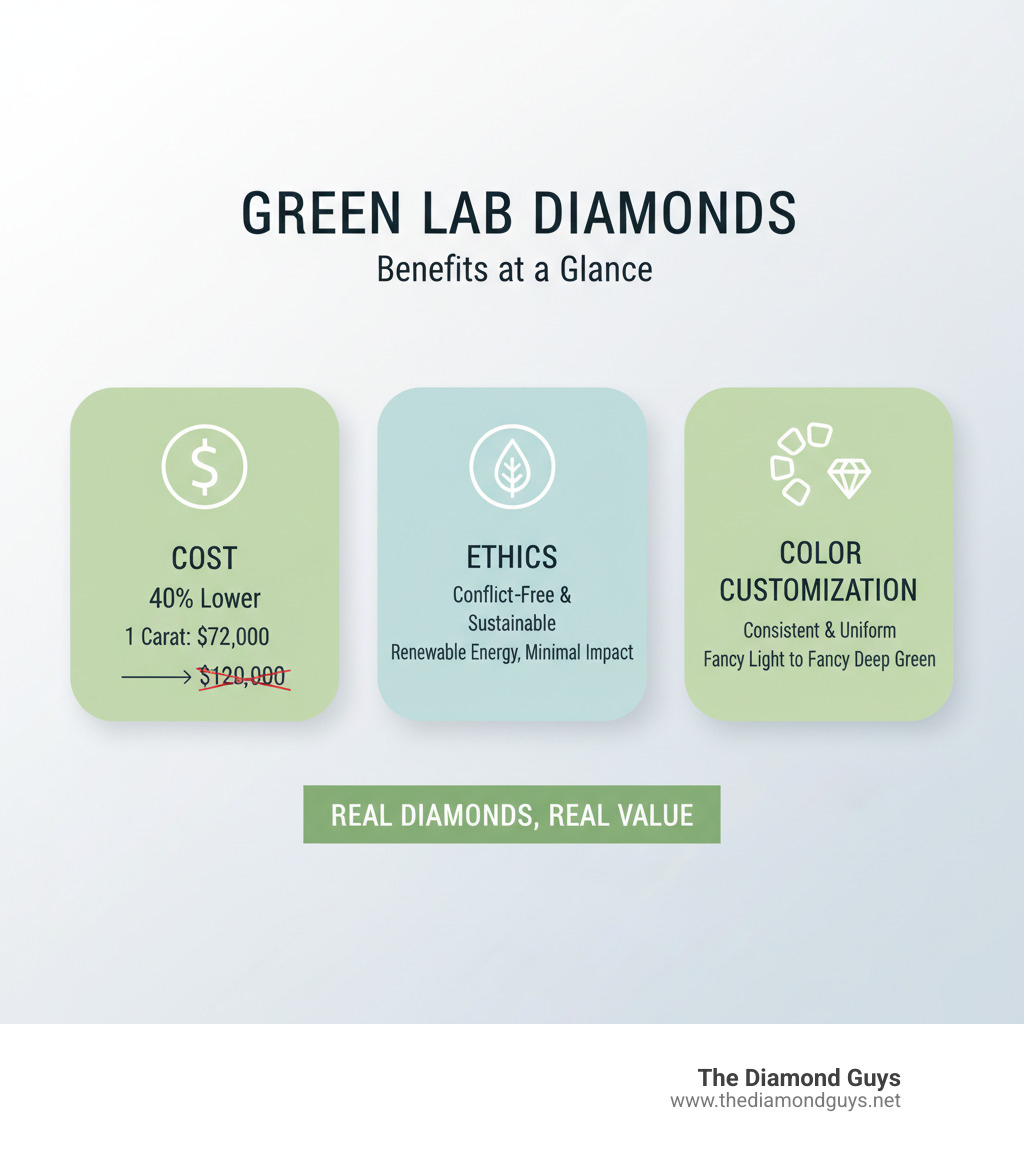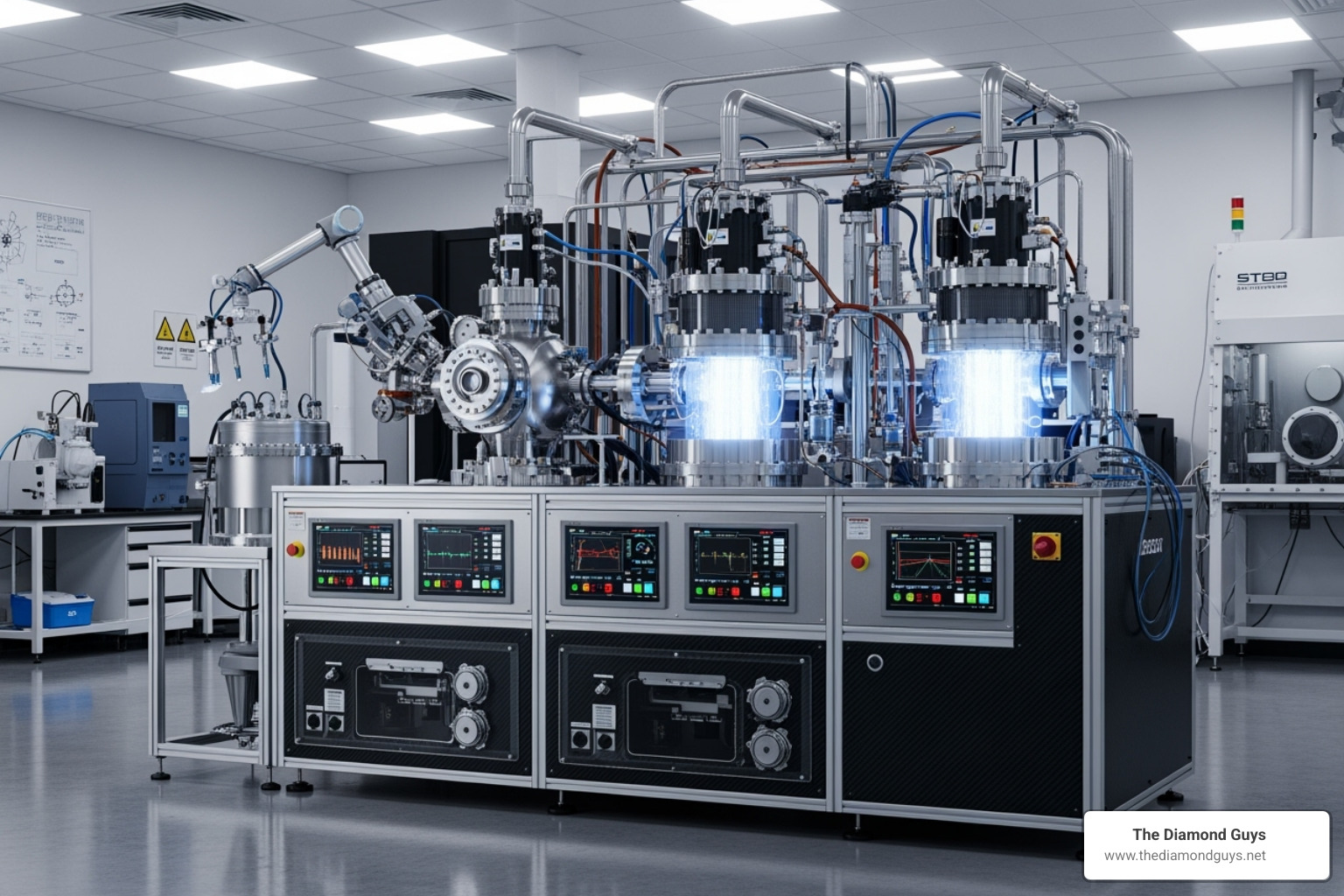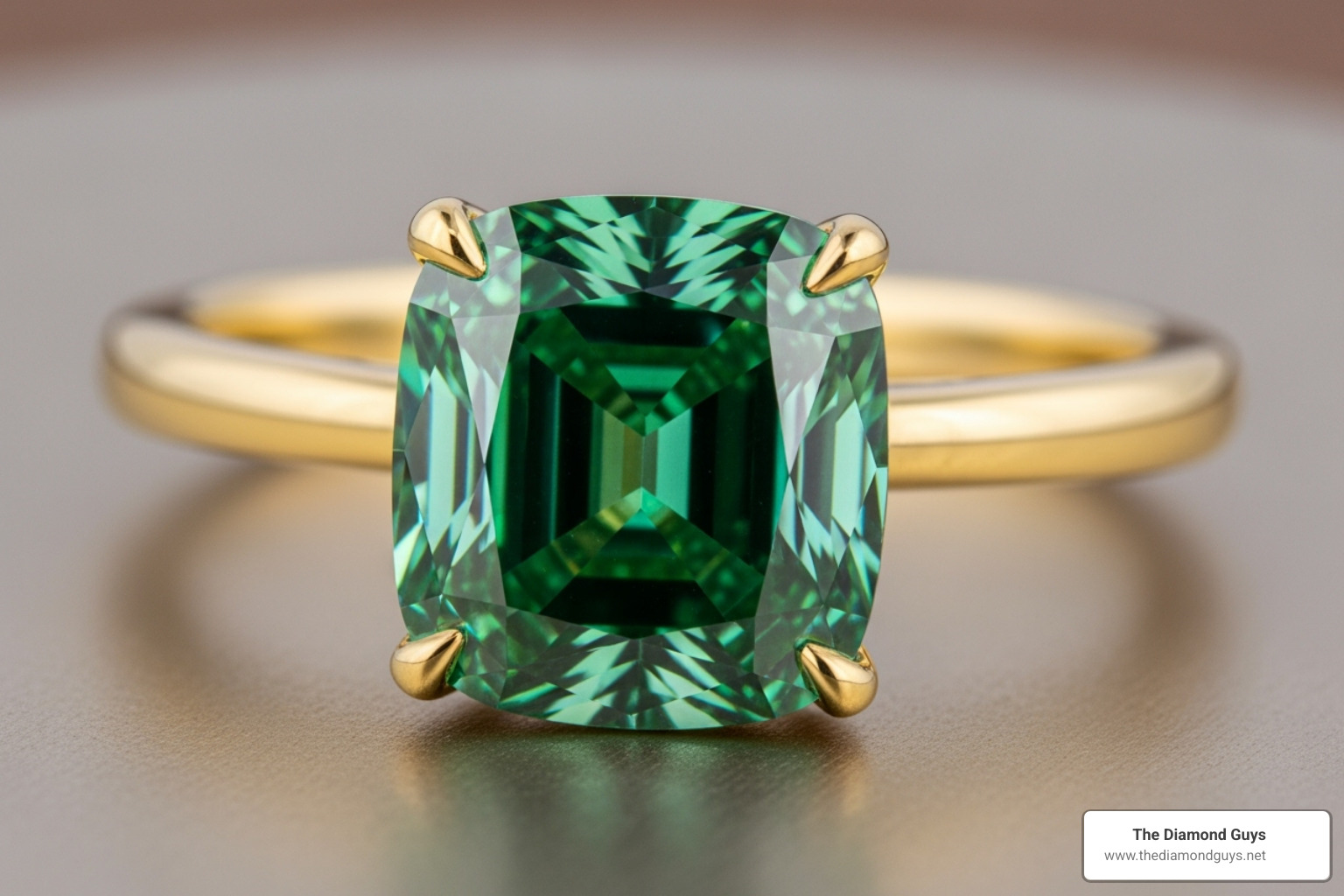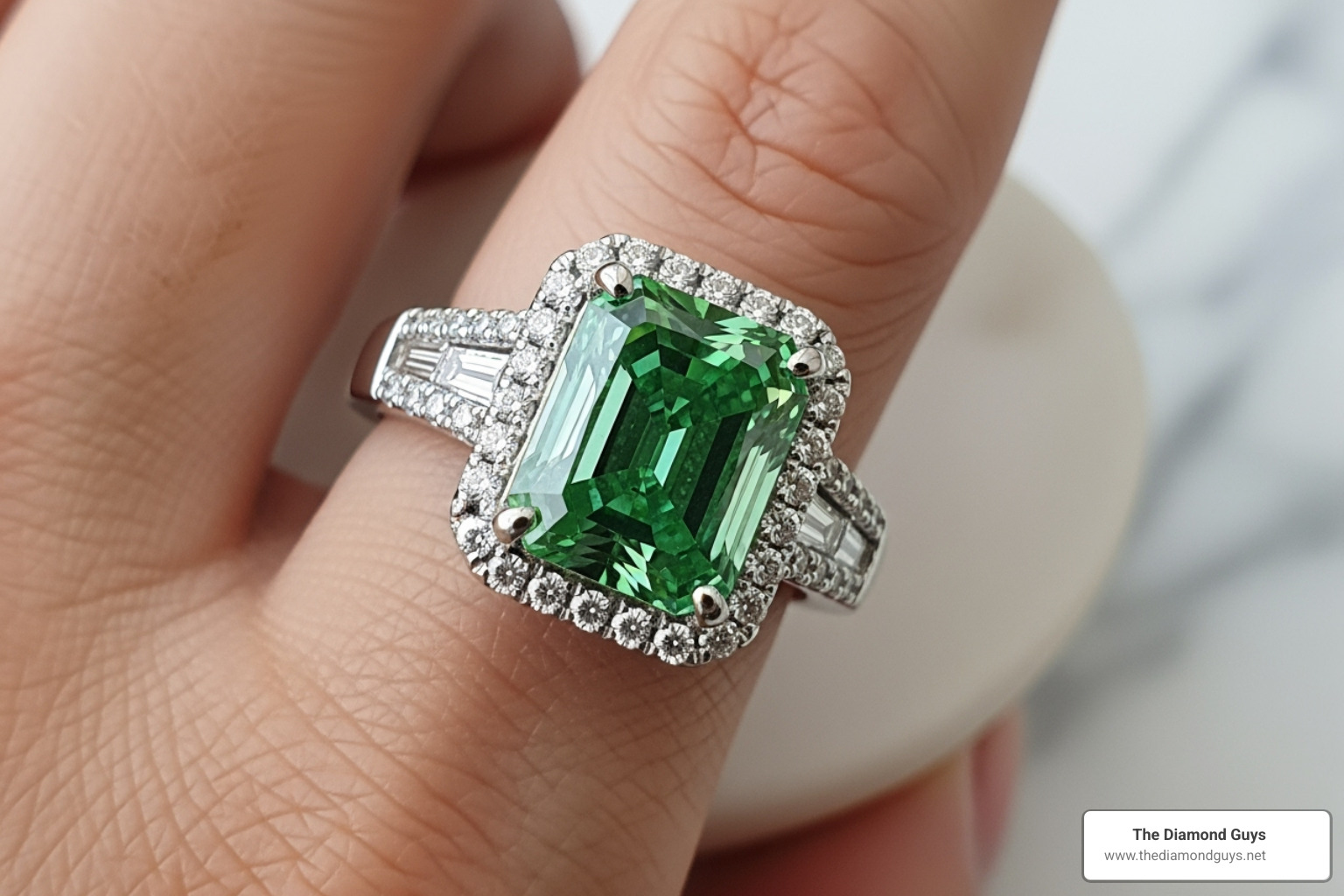From Lab to Luster: The Story of Green Lab Grown Diamonds
Why Green Lab Diamonds Are Capturing Hearts (and Budgets)
Green lab diamonds are laboratory-created diamonds with a stunning green color. They offer the same brilliance and durability as natural diamonds for about 40% less than their rare natural counterparts.
Quick Facts About Green Lab Diamonds:
- What They Are: Real diamonds grown in controlled lab environments with green coloration
- Cost: A 1-carat green lab diamond costs around $72,000 vs. $120,000 for natural
- Rarity: Natural green diamonds represent less than 0.1% of all mined diamonds
- Color Range: From Fancy Light Green to Fancy Deep Green (GIA graded)
- Ethics: Conflict-free, sustainable, and environmentally responsible
- Quality: Identical chemical composition (pure carbon) to natural diamonds
Natural green diamonds are among the rarest gemstones on Earth, and for decades, only wealthy collectors could afford them. Modern technology has changed everything.
In 2024, 52% of couples chose lab-grown diamonds for their engagement rings—a 40% jump since 2019. They found they could get more beauty, size, and peace of mind for less money. Green lab diamonds take this trend further, offering a unique color that stands out from traditional white diamonds while maintaining all the expected sparkle and durability.
These aren't imitations. Green lab diamonds are real diamonds with the same hardness, brilliance, and fire as any stone pulled from the earth. The difference is their origin—and how much you'll pay.
I'm Morgan Price, and I've spent years helping couples steer the diamond industry, focusing on the ethical and quality advantages of green lab diamonds. I've seen how these stones offer uniqueness and value without compromise.
This guide covers everything you need to know: how green lab diamonds are made, what causes their color, how to value them, and how to choose the perfect setting for your gem.

The Science of Green: How Are Green Lab Diamonds Made?
Creating a green lab diamond combines cutting-edge technology with scientific control to replicate what nature takes billions of years to accomplish. Scientists have perfected diamond growth over decades. If you're curious about the history, you can explore the History of Lab-Grown Diamonds: How Long Have Lab-Grown Diamonds Been Around. Here’s how these green gems are made today.
There are two main methods for growing diamonds in a lab: High-Pressure/High-Temperature (HPHT) and Chemical Vapor Deposition (CVD).
The HPHT method recreates the intense conditions deep within the Earth's mantle. A tiny diamond seed is placed in a chamber with carbon and a metal catalyst. Extreme pressure (around 5.5 gigapascals) and temperatures (1300-1600°C) are applied, causing the carbon to dissolve and crystallize around the seed, forming a larger diamond. This method works well for creating yellow, blue, and certain shades of green lab diamonds.
The CVD method places a diamond seed in a sealed chamber with carbon-rich gases like methane. Energy breaks down the gases, releasing carbon atoms that build upon the seed, atom by atom. CVD offers incredible precision for controlling color, making it popular for fancy colored diamonds like green.
After growth, most green lab diamonds undergo post-growth treatments like controlled radiation and annealing (heat treatment) to achieve their final, uniform color. This ensures the green hue is consistent throughout the stone—unlike many natural green diamonds where color is only surface-deep.
Modern labs control every variable with precision, creating green lab diamonds that often surpass their natural counterparts in color consistency and saturation.

What Causes the Unique Color in a Green Lab Diamond?
That mesmerizing green color is the result of specific atomic-level changes in the diamond's crystal structure.
Natural green diamonds get their color from millions of years of radiation exposure near radioactive rocks, which often results in uneven, surface-only color.
Green lab diamonds achieve their color through controlled scientific processes that create uniform, vibrant green throughout the entire stone. The magic happens through radiation exposure in a managed environment. This creates GR1 defects in the crystal lattice, which absorb certain wavelengths of light and reflect others, giving the diamond its green appearance.
Nitrogen impurities can also play a role. While nitrogen usually creates yellow tints, when combined with radiation-induced defects, it can contribute to green coloration. Similarly, trace amounts of nickel impurities during HPHT growth can produce beautiful green hues.
The advantage of a lab is precision. Scientists control radiation exposure and impurities to achieve consistent, uniform color throughout the entire diamond.
These lattice defects are permanent and stable, meaning the color won't fade. The result is a range of stunning greens, from delicate sage tones to deep, vivid emerald shades.
Are Lab-Grown Diamonds Real Diamonds?
Yes, green lab diamonds are real diamonds. They are not simulants or fakes.
Chemically, a green lab diamond is pure carbon arranged in an iconic crystalline lattice—identical to a diamond pulled from a mine.
They share the same physical properties, ranking 10 on the Mohs hardness scale. They have the same density, refractive index, and dispersion, meaning they create that breathtaking sparkle—fire and brilliance—in exactly the same way.
When light enters a green lab diamond, it behaves with identical optical brilliance, creating the same dazzling display that makes diamonds so captivating.
Even trained jewelers can't tell the difference with the naked eye. A green lab diamond and a natural green diamond are indistinguishable without specialized equipment. It takes advanced gemological instruments to spot the subtle growth patterns that reveal a diamond's origin.
If you want to dive deeper, we've put together a comprehensive guide: Are Lab-Grown Diamonds Real Diamonds.
The bottom line? When you choose a green lab diamond, you're getting a genuine diamond with the same beauty, durability, and sparkle as any stone formed deep in the Earth. The only difference is the journey it took to get to you.
Green Lab Diamonds: A Clear Comparison
When considering a green lab diamond, it's helpful to compare it to its natural counterpart. Though chemically and physically identical, their origins are vastly different.
Natural green diamonds form over billions of years deep within the Earth's mantle and are extraordinarily rare. In contrast, green lab diamonds are created in controlled labs within weeks. Natural green diamonds often have surface-only color from natural radiation. Lab-grown green diamonds, however, have uniform color distribution throughout the entire stone due to precise controls, ensuring a consistent hue from every angle.
Let's look at the key differences:
| Feature | Natural Green Diamond | Green Lab-Grown Diamond |
|---|---|---|
| Origin | Formed in Earth's mantle over billions of years | Created in controlled laboratories within weeks |
| Rarity | Extremely rare (less than 0.1% of all diamonds) | More readily available through advanced technology |
| Cost | Significantly higher (a 1-carat can cost $120,000+) | 40-60% less expensive (around $72,000 for 1 carat) |
| Color Consistency | Often surface-only coloration, can be uneven | Uniform color distribution throughout the entire stone |
| Environmental Impact | Mining causes land disruption, habitat destruction, high carbon emissions | Minimal land use, reduced carbon footprint, often powered by renewable energy |
| Ethical Sourcing | Potential concerns about conflict diamonds and labor practices | Guaranteed conflict-free with transparent supply chains |
The Ethical and Environmental Edge
The ethical and environmental benefits are where green lab diamonds truly shine. Choosing one is a decision that goes beyond aesthetics and budget.
Mining natural diamonds has a significant environmental toll, including ecosystem disruption, habitat destruction, and high water and energy consumption. The industry has also faced challenges with labor practices and conflict diamonds.
Green lab diamonds offer a refreshing alternative. They're created in facilities that increasingly use renewable energy, like solar power. The process involves no land disruption, no habitat destruction, and significantly less water consumption.
Green lab diamonds also come with a conflict-free guarantee and a transparent supply chain. For couples who want their symbol of love to reflect their values, this peace of mind is priceless.
If you're interested in learning more, take a look at our guide on Ethical and sustainable jewelry practices.
Can an Expert Tell the Difference?
A common question we hear at our showrooms in Scottsdale and Los Angeles is, "Can anyone tell my diamond is lab-grown?"
The short answer is no—not without specialized equipment.
Green lab diamonds are chemically, physically, and optically identical to natural green diamonds. To the naked eye—even a trained jeweler's eye—they're indistinguishable.
The only way to definitively identify a lab-grown diamond is through specialized gemological equipment that can detect subtle differences in crystal growth patterns. Reputable labs like GIA and IGI use these tools to make this determination. Your certified green lab diamond will also have a microscopic laser inscription on its girdle identifying it as lab-grown.
This is a good thing. It means you get all the beauty of a rare green diamond without the ethical concerns or the high price tag. For more details, read our article: Can a Jeweler Tell the Difference Between Lab-Grown Diamonds.
The bottom line is that your green lab diamond will look, feel, and perform exactly like a natural diamond. The only difference is its origin story—one you can feel good about.
Styling Your Green Gem: Popular Designs and Settings
Seeing a green lab diamond come to life in the perfect setting is magical. I've helped countless clients create unique engagement rings, wedding bands, and statement necklaces that reflect their personal style.
The versatility of green lab diamonds is exciting. Their color range, from soft sage to deep forest green, allows for incredible personal expression. We've designed engagement rings for couples who wanted something that truly reflected their unique relationship. We've also created wedding bands with tiny green lab diamonds for a pop of color and crafted show-stopping necklaces and earrings.
A green lab diamond engagement ring symbolizes growth, harmony, and a commitment as unique as your love story. This unique green diamond ring inspiration is a stunning example of how a cushion-cut green diamond can shine in yellow gold.

Choosing the Perfect Setting for Your Green Lab Diamond
The right setting doesn't just hold your diamond—it transforms it. Choosing the metal and design is where your personality really shines.
Yellow gold is a go-to recommendation for many green lab diamonds. Its warm tone complements green stones, especially those with yellow undertones, creating a timeless, vintage-inspired look.
Platinum and white gold provide a cool, crisp contrast that makes your green lab diamond pop. These silvery tones create a contemporary, sophisticated look that works beautifully with deeper greens.
Rose gold has become popular for a romantic and unexpected look. The soft, peachy tones create a gentle contrast with lighter, sage-like green lab diamonds.
For setting styles, a solitaire setting lets your green lab diamond take center stage. A halo design, with smaller white diamonds surrounding the center stone, amplifies size and sparkle. Vintage-inspired settings with intricate details pair wonderfully with green diamonds, giving them an heirloom quality.

Trending Jewelry Styles
We're seeing exciting trends with green lab diamonds. "Moody" or "sagey" green tones are having a major moment. These sophisticated, earthy shades shift in the light and are perfect for a modern, understated look.
Cushion cuts are a favorite because they maximize fire and disperse the green color beautifully. Radiant cuts are another popular choice for those who love intense sparkle.
We're also seeing more three-stone rings with a green lab diamond center stone, flanked by white diamonds. The design creates a balanced look symbolizing the past, present, and future. East-west settings—where an oval or emerald-cut stone sits horizontally—offer a fresh, contemporary alternative.
Because green lab diamonds are more accessible, we can create truly custom, one-of-a-kind designs without breaking the bank. We love helping clients design a piece that tells their unique story.
Frequently Asked Questions about Green Lab Diamonds
Choosing a diamond is a big moment, and you likely have questions. Let's talk through some common queries about green lab diamonds.
Do green lab-grown diamonds fade or get cloudy?
No, your green lab diamond will never fade or turn cloudy. The color is permanent and part of the diamond's atomic structure, ensuring it stays crystal clear for generations.
Diamonds are the hardest known natural substance. Your green lab diamond has the same incredible durability as any natural diamond and is virtually impossible to scratch.
While the diamond itself won't change, it can appear less sparkly if dirt and oils build up on the surface. This is normal for all jewelry, and a quick, gentle cleaning will restore its gorgeous green brilliance.
Your green lab diamond will look just as stunning decades from now as it does today. For more on this, our guide on Do Lab-Grown Diamonds Get Cloudy has you covered.
Are green lab diamonds a good investment?
If you're asking about financial appreciation like stocks, the answer is probably not. This is true for most diamonds, both natural and lab-grown, which are not traditional financial investments.
Instead, consider the personal and emotional value. When you choose a green lab diamond, you're investing in exceptional beauty at a price that makes sense. Because they cost about 40% less than natural green diamonds, you can afford a larger stone or a higher quality cut, getting more beauty for your budget.
The emotional value is where the real return happens. A green lab diamond represents your commitment, love story, and unique style. For many couples, there's added value in knowing their diamond was created ethically and sustainably. That peace of mind is priceless.
The market agrees: 52% of couples now choose lab-grown diamonds for their engagement rings, as noted in this market trend report for lab-grown diamonds. This is a fundamental shift in how people think about diamonds.
So yes, a green lab diamond is a smart investment when measured by what truly matters: beauty, meaning, and your values. For more on this, check out our guide Should I Buy a Lab-Grown Diamond Engagement Ring.
How do I care for my green diamond jewelry?
Caring for your green lab diamond is simple and requires the same gentle attention as any fine jewelry.
The best cleaning method is to soak your jewelry for 20-40 minutes in a small bowl of warm water with a few drops of mild dish soap. This loosens any dirt and oils.
After soaking, use a soft-bristle toothbrush to gently brush around the diamond and setting. Rinse thoroughly under warm running water (with the drain closed!) and dry with a soft, lint-free cloth.
Avoid harsh chemicals like bleach or chlorine, which can damage the metal setting. Also, skip ultrasonic cleaners at home unless we've confirmed your setting can handle it.
When not wearing your jewelry, store it in a soft pouch or a separate compartment to prevent scratching other pieces.
We recommend bringing your green lab diamond jewelry to us for a professional cleaning and inspection once a year. We'll check the prongs, look for wear, and give it a deep clean. With these simple habits, your green gem will stay gorgeous for decades.
Conclusion
We've explored the captivating world of green lab diamonds, from their scientific creation to the reasons they're a beloved choice for modern couples.
What makes green lab diamonds truly special is the complete package they offer. You get exceptional beauty, genuine diamond quality, and the peace of mind that comes from an ethical and sustainable choice. They also provide incredible value, allowing you to get a larger or higher-quality stone for your budget without breaking the bank.
When you choose a green lab diamond, you're making a statement that your love is modern, conscious, and unique. You're embracing innovation while honoring tradition—getting a rare and stunning green diamond that represents your values without the ethical concerns or high price of natural green diamonds.
At The Diamond Guys, we've helped countless couples find their perfect diamond, and we'd be honored to help you too. We know this is a personal decision, and we're here to guide you with expert knowledge and genuine care. Whether you're drawn to a moody sage green or a vivid emerald hue, we'll help you find the green lab diamond that makes your heart skip a beat.
Your perfect green gem is out there. We're here to help you find it and create something truly extraordinary together. Ready to start your journey? Explore the differences between lab and natural diamonds further and see why so many couples are choosing lab-grown diamonds.




